

The grass plants that make up your lawn need water to live. Without it, they can’t photosynthesise (create energy), or move nutrients around their leaves.
The grass plant obtains most of its water from the soil. If the soil is left to dry out for several days, the grass plant’s growth will start to slow down. If left without water any longer, the grass plants will go dormant and eventually dry out. In most cases, the grass plants will start to grow again once they have access to water. However, allowing the grass to dry out will reduce the quality of your lawn when the plants do start to grow again.
Alongside lawn mowing, watering is one of the key factors that will determine the overall quality of your lawn and the benefit your lawn will get from our treatments and services.
How do I know if my lawn needs watering?
As temperatures rise, the grass plants require more water to stay hydrated. Between April and October, if there has been less than 20 minutes of continuous rain during the day, your lawn will most likely need watering. You can also check how dry the soil is to determine if it requires watering.
The easiest way to check is to use a metal object such as a screwdriver and insert it in to the soil. If it can be easily inserted, that generally means it is damp enough. If you are unable to insert the screwdriver or if it is dry when you remove it, you should water your lawn.
There are also several signs to look out for:
1. The first sign that your lawn will show is one that isn’t so obvious. When the grass plants in your lawn detect a lack of water, they will enter survival mode. This will force the grass plants to try and reproduce by creating seeds.


Above: Grass seeds will rise above the lawn in an attempt to reproduce when in survival mode
2. If your lawn is left unwatered or there is a reduced amount of rain for much longer, the soil in the first few inches of your lawn will dry out, and the grass plants will no longer be able to sustain their green leaves. Some areas of your lawn might start to go brown quicker than others. These areas, often the ones that are walked upon the most, are referred to as localised-compaction areas. Although in some lawns localised compaction can happen anywhere.
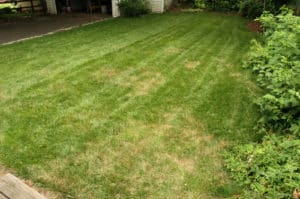

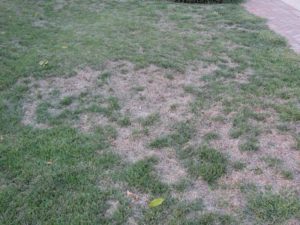

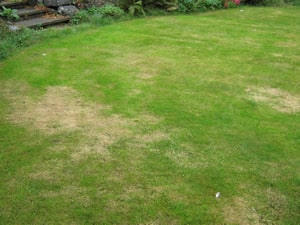

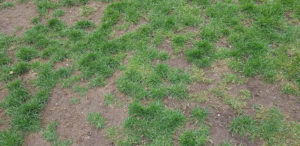

Above: Areas of localised compaction where the lawn has dried out quicker than the surrounding areas
What should I expect when I water a lawn that has been left unwatered?
The plants will start to absorb the water to help them create energy and grow new leaves. Your lawn will start to become greener and the grass plants will start to grow again.
If the soil in your lawn has been left unwatered and the soil is allowed to dry out, small areas of soil will start to compact quicker than others. When you start to water your lawn again, it is common for these areas to remain dry.
Watering your lawn
Watering your lawn is the only way of giving the grass plants access to water during periods of low or no rainfall. Our advice focuses on how to water your lawn in the most efficient manner whilst minimising the amount of water required.
The biggest mistakes our customers make when watering a lawn
The biggest mistake that customers make when watering their lawn is thinking that they have watered enough. Giving your lawn a quick sprinkle every few days when there has been no rain will have very little effect, especially on compacted soil.
It is important that the water penetrates the surface of the soil and reaches down to the root zone, so even though the surface may seem wet, the soil itself can still be bone dry if it is not watered enough.
When is the best time of day for me to water my lawn?
The best time of the day to water a lawn is after the sun goes down. There are many reasons to water your lawn at this time. For example:
1. Water is evaporated by sunlight. Most watering systems create a spray or a mist that is sprayed over the lawn. Watering when the sun goes down will maximise the amount of water that reaches the soil. When the sun is up, water that does find its way to the soil level can still evaporate if it doesn’t soak into the soil straight away, further reducing the amount of water that penetrates through the soil.
2. Water droplets that fall onto the leaves of the grass plants can cause burns as they magnify sunlight. This is a similar effect to concentrating a magnifying glass on a small area.
What equipment do I need to water my lawn?
When it comes to equipment, there are a few different options available.
Garden sprinkler
At its most basic, watering can be carried out using a garden hose and a sprinkler. There are various different types of sprinklers, all of which do very much the same thing. Oscillating sprinklers will create an arc, watering your lawn in a rectangular shape. Impulse sprinklers will water your lawn in a circular pattern.
To ensure your lawn is watered at night, you can install a timer that will automatically turn the sprinklers on and off at set times.
![professional-impulse-sprinkler-triton-361-p[ekm]1000×1000[ekm] professional-impulse-sprinkler-triton-361-p[ekm]1000x1000[ekm]](https://greenmanlawncare.co.uk/wp-content/uploads/elementor/thumbs/professional-impulse-sprinkler-triton-361-pekm1000x1000ekm-o64ky79ojeyeitwm565o1coeizgt13zq5hb3wxn5x4.jpg)
![professional-impulse-sprinkler-triton-361-p[ekm]1000×1000[ekm] professional-impulse-sprinkler-triton-361-p[ekm]1000x1000[ekm]](https://greenmanlawncare.co.uk/wp-content/uploads/elementor/thumbs/professional-impulse-sprinkler-triton-361-pekm1000x1000ekm-o64ky79ojeyeitwm565o1coeizgt13zq5hb3wxn5x4.jpg)
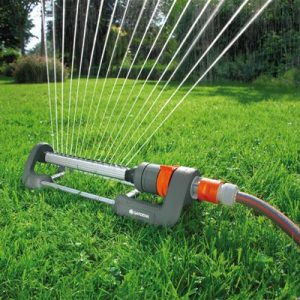

An impulse sprinkler will water your lawn in a circular pattern
An oscillating sprinkler will water your lawn in a rectangular pattern
Installed irrigation system
A more advanced method is to use an installed irrigation system. These are installed into your lawn, and there are a variety of different sprinkler patterns available to ensure the irrigation system covers your entire lawn. An irrigation system will cost more than just a regular sprinkler due to the price of installation, but in most cases will be a lot more efficient.
Can I use a handheld sprinkler, like the one I use to water my plants with?
No. Handheld sprinklers are great for watering your flowers and vegetables with, but lawns require a uniform flow of water over them to ensure they receive a sufficient amount of water throughout the soil. A lawn will also require around 30 minutes of watering to sufficiently wet the soil, and it is more often the case that when watering by hand, the amount of time spent is reduced considerabley
What is the best method of watering my lawn?
The aim of watering a lawn is to ensure water penetrates the surface of the soil, down into the root zone. Applying too much water in one go can cause puddling, and may reduce the amount of water that eventually reaches through the soil. To maximise the amount of water that reaches through the soil level, it is best to water using the following method:
1. Water an area for 20 to 30 minutes.
2. After 20 to 30 minutes, stop watering and allow the water to soak into the soil.
3. After another 20 to 30 minutes, start watering the same area again, and water for another 20 to 30 minutes.
Lawns that have an excessive amount of thatch or the soil is excessively compact throughout or in localised areas will require a longer amount of watering as the thatch layer will act like a sponge, absorbing a lot of the water, and it will take longer for the water to penetrate compacted soil.
How do I know when my lawn is sufficiently watered?
The most important area of the soil and one that must remain wet at all times is the first 3 inches. This is the area where the grass plants’ roots grow. It is difficult to calculate how much watering is required to maintain a sufficient level of water in this area, so visually checking is the best way. You can dig a small hole and check how far down the soil is wet.
In most cases, following our watering guide above will give your lawn a sufficient amount of water, assuming you water at night and that the surface of your lawn has no more than an average amount of thatch.
Is there anything else I can do to help maximise the amount of water that is retained in the soil?
Yes. You can spike your lawn. Spiking is the process of creating small holes in your lawn. This can be done using a rolling spiker, or even just a garden fork. It is easier and better for the grass plants if you do this when the soil is wet.
By creating small holes in your lawn, you are giving water space to hide from the sun and helping to reduce the amount that is evaporated. It also allows the soil around the holes to slowly soak the water in. If your lawn has thatch, spiking will not only help water reach the soil layer, but will also help to reduce the level of thatch by improving the airflow around the thatch layer.
When spiking your lawn, you should prioritise the areas of local compaction.


Are there any lawn treatments available to help maximise the amount of water applied to my lawn?
What happens if I don't water my lawn?
The grass plants will eventually become dormant and will dry out. Your lawn will look very brown and yellow, and weeds will start to take over fairly quickly.
The soil will start to develop areas of localised compaction (see above), and will require some form of renovation to fix.
